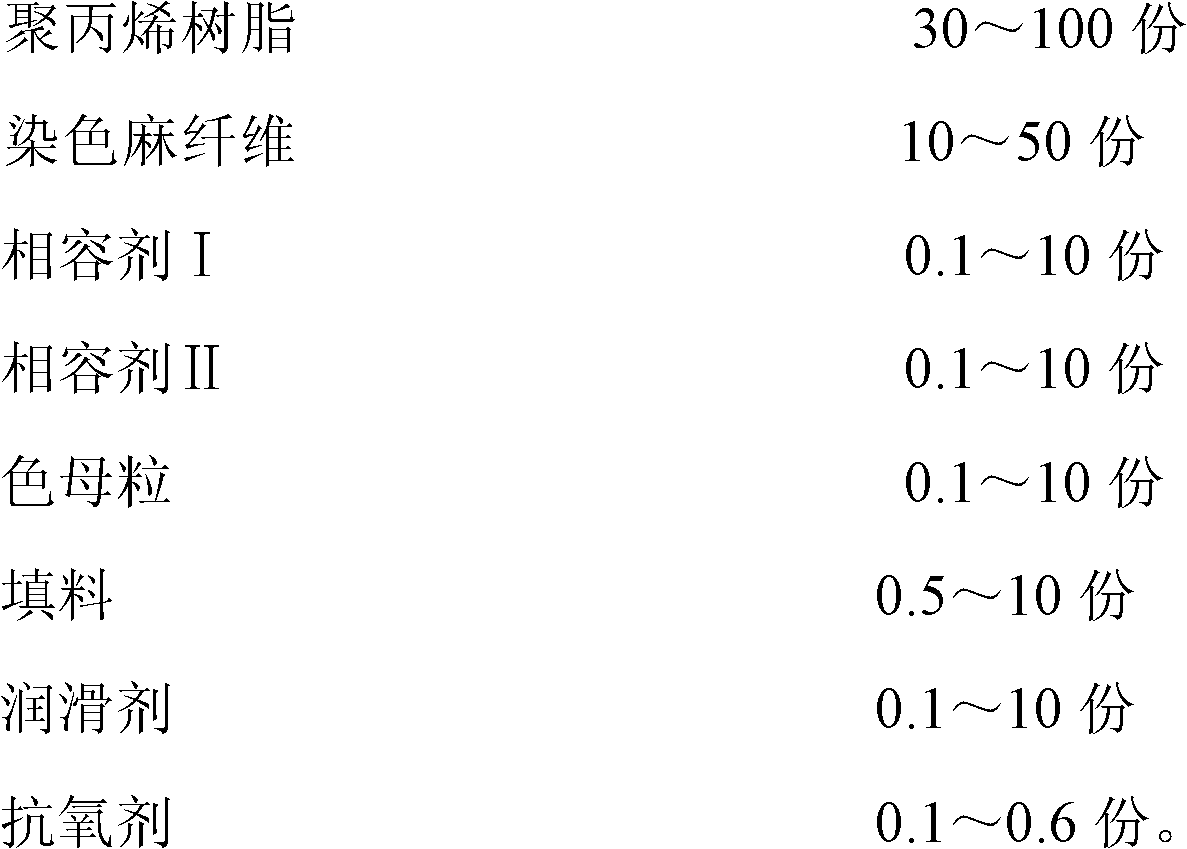Dyeing bastose and modified polypropylene particle prepared from same
A technology of polypropylene particles and hemp fibers, which is used in dyeing, textiles and papermaking, etc., can solve the problem that the surface quality of natural fiber-filled modified plastics is difficult to ensure, the grafting rate is low, the interface adhesion is difficult, and the coupling effect is affected. and other problems, to achieve the effect of bright color, bright surface and good compatibility
- Summary
- Abstract
- Description
- Claims
- Application Information
AI Technical Summary
Problems solved by technology
Method used
Image
Examples
Embodiment 1
[0031] The dyed hemp fibers were prepared using the following steps:
[0032] (1) Cut or grind the sisal fibers to 2mm to obtain 100 parts of chopped hemp fibers; place the chopped hemp fibers in an aqueous solution of sodium hydroxide (10% by mass) and soak them for 1 min, then rinse with clear water Rinse, centrifugally dry the water, and then dry it until the mass moisture content is 8%, so as to obtain alkali-washed chopped hemp fibers;
[0033] (2) Add 0.2 parts of silane coupling agent and 2 parts of oil-soluble black (heat-resistant temperature ≥ 300°C) to alcohol in sequence, and stir evenly to obtain hemp fiber impregnated alcohol solution;
[0034] (3) the chopped hemp fiber of step (1) gained alkali washing is poured in step (2) gained hemp fiber impregnation alcohol solution, the mass ratio of the chopped hemp fiber of alkali washing and hemp fiber impregnation alcohol solution is 1:5 Stirring for 10 minutes, storing for 24 hours, centrifuging to dry the solution,...
Embodiment 2
[0044] The dyed hemp fibers were prepared using the following steps:
[0045] (1) Cutting or grinding the ramie fibers to 1 mm to obtain 100 parts of chopped hemp fibers; soaking the chopped hemp fibers in aqueous sodium hydroxide solution (3% by mass) and stirring for 20 minutes, then rinsed with water , after centrifuging to dry the water, dry to a mass moisture content of 8%, to obtain alkali-washed chopped hemp fibers;
[0046](2) Add 0.1 part of titanate coupling agent and 0.1 part of nigrosin black (heat-resistant temperature ≥ 300°C) to alcohol in sequence, and stir evenly to obtain hemp fiber impregnated alcohol solution;
[0047] (3) the chopped hemp fiber of step (1) gained alkali washing is poured in step (2) gained hemp fiber impregnation alcohol solution, the mass ratio of the chopped hemp fiber of alkali washing and hemp fiber impregnation alcohol solution is 1: 1 Stirring for 5 minutes and storing for 24 hours, centrifuging to dry the solution, and then vacuum ...
Embodiment 3
[0057] The dyed hemp fibers were prepared using the following steps:
[0058] (1) Cut or grind the flax fibers to 3 mm to obtain 100 parts of chopped hemp fibers; soak and stir the chopped hemp fibers in aqueous sodium hydroxide solution (1% by mass) for 10 minutes, then rinse with water , after centrifuging to dry the water, dry to a mass moisture content of 9%, to obtain alkali-washed chopped hemp fibers;
[0059] (2) Add 5 parts of aluminate coupling agent and 5 parts of oil-soluble red (heat-resistant temperature ≥ 300°C) into alcohol in turn, stir evenly to obtain hemp fiber impregnated alcohol solution;
[0060] (3) the chopped hemp fiber of step (1) gained alkali washing is poured in step (2) gained hemp fiber impregnation alcohol solution, the mass ratio of the chopped hemp fiber of alkali washing and hemp fiber impregnation alcohol solution is 1: 3 Stirring for 30 minutes, storing for 2 hours, centrifuging to dry the solution, and then vacuum-drying at 100° C. until ...
PUM
| Property | Measurement | Unit |
|---|---|---|
| thermal resistance | aaaaa | aaaaa |
| density | aaaaa | aaaaa |
| tensile strength | aaaaa | aaaaa |
Abstract
Description
Claims
Application Information
 Login to View More
Login to View More - R&D
- Intellectual Property
- Life Sciences
- Materials
- Tech Scout
- Unparalleled Data Quality
- Higher Quality Content
- 60% Fewer Hallucinations
Browse by: Latest US Patents, China's latest patents, Technical Efficacy Thesaurus, Application Domain, Technology Topic, Popular Technical Reports.
© 2025 PatSnap. All rights reserved.Legal|Privacy policy|Modern Slavery Act Transparency Statement|Sitemap|About US| Contact US: help@patsnap.com

